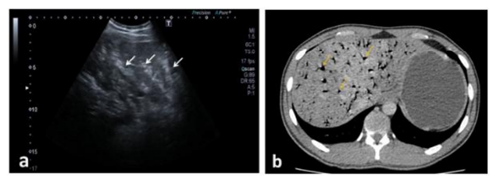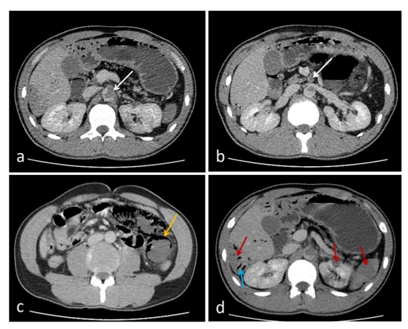Information
Journal Policies
Delayed Presentation of Massive Cocaine-Induced Enteropathy: Report of a Fatalcase
Fatma Zeynep Arslan1*, Zeynep Keskin1, Hatice Kivrak1, Serdar Arslan2, Mehmet Karagulle2
2.Department of Radiology, University of HealthScience, Bağcılar Trainning and Research Hospital, İstanbul, Turkey.
Copyright :© 2018 Authors. This is an open-access article distributed under the terms of the Creative Commons Attribution License, which permits unrestricted use, distribution, and reproduction in any medium, provided the original author and source are credited.
Cocaine-induced tissue injury is frequently seen, important health issue, especially presented as myocardial ischemia and infarction. Cocaine-induced gastrointestinal complications are fatal as well as unexpected. The toxic effects of cocaine causes thrombosis by damaging endothelium cells and leading to intimal hypertrophy or atherosclerosis(4).Thus substance-abuse may cause vascular complications and end organ ischemia. Acute mesenteric ischaemia(AMI) is a vascular emergency in the setting of inadequete blood supply to the intestine causing tissue necrosis. We presented the ultrasonography(USG) and computed tomography (CT) findings of a 30-year-old male with AMI accompanying extensive thrombosis in mesenteric vascular structures after substance abuse.
Ischemia, substance abuse , cocaine-induced enteropathy ,Radiology and Medical Imaging
1. Introduction
Cocaine-induced tissue injury is frequently seen, important health issue, especially presented as myocardial ischemia and infarction [1]. Cocaine-induced gastrointestinal complications are fatal as well as unexpected. Acute mesenteric ischaemia(AMI) is a vascular emergency in the setting of inadequete blood supply to the intestine causing tissue necrosis[2] and usually affect senior population. In the setting of AMI in young adults, underlying factors should always investigate such as inherited thombophilias, various rheumatologic diseases, vasculitis and toxicological evaluation. We presented the ultrasonography(USG) and computed tomography (CT) findings of a 30-year-old male with AMI accompanying extensive thrombosis in mesenteric vascular structures after substance abuse.
2. Case Report
A 30-year-old patient with a history of substance-abuse presented to the emergency department with extensive abdominal pain. On his initial laboratory finding serum aspartate aminotransferase level was:1650 units/L (references:40 units/L), alanine amino transferase level was:1919 units/L (references:45 units/L), white blood count was 32x109 (references: 4 X 109/L and 1.1 X 1010/L).
There was a widespread tenderness in the abdomen on physical examination with the palpation. Plain radiograph was non spesific(Figure 1).
Abdominal USG was performed. Liver parenchyma was heterogenous and extensive, echogenic foci with shadowing in portal vascular structures was seen on USG(Figure 2). Hypoechoic intestinal wall was seen due to oedema. Contrast enhanced CT revealed multiple, irregular, hypointense areas corresponding to acute enfarct on left and right lobe of liver, left kidney and spleen(Figure 3). Extensive gas densities within portal vascular structures was also noted in CT.
Localised intramural gas within intestinal wall and mesenteric oedema was presented(Figure 3). Findings was corresponding to pneumatosis portalis and intestinalis. Thrombus materials obstructing almost entire vessel lumen were observed in the celiac artery, superior mesenteric artery, splenic artery and left renal artery level of aorta on CT anjiography. The patient expired after an urgent operation. Autopsy confirmed radiological diagnosis.
3. Discussion
Pneumatosis portalis and intestinalis is an ominous, rare radiological findings characterized with localised intramural gas within intestinal wall and in portal venous structures due to intestinal necrosis and ischemia. Detected gas in portomesenteric structures has been reported to be associated with mortality above 75% [3]. The toxic effects of cocaine causes thrombosis by damaging endothelium cells and leading to intimal hypertrophy or atherosclerosis[4].Thus substance-abuse may cause vascular complications and end organ ischemia.
Elramah et al. reported that in a significant number cases with gastrointestinal complications had delayed presentation more than 72 hours; which make it difficult to diagnose[5]. In our patients; we could not obtain the proper information about drug-abuse, after our patient reinterrogated, history of cocain use was noted 5 days before the clinical picture. AMI is a rare, fatal complication of an important and common health issue; since subtance abuse is a taboo, it increases the importance of trust in the patient physician relationship. AMI patients usually presented with severe abdominal pain and rectal bleeding. Urgent radiologic diagnosis is necessary as prompt surgical intervention is crucial. USG, CT and CT anjiography are the chose of modalities. Definitive diagnosis can be obtain using anjiography by demonstrating trombosis of mesentheric vascular structures. Sonographically hypoechoic intestinal wall, hypointense areas corresponding to acute enfarct on solid organ parenchyma and echogenic foci with shadowing in portal vascular structures can be seen. Gas in the portomesentheric structures and within the intestinal wall may be detect on abdominal CT. CT anjiography may reveal etiology by demonstrating thromboembolism in mesenteric artery and veins. Submucosal oedema may produce low density and thickenning of the watershead areas of the intestinal wall can be monitorized, free intraperitoneal gas can be detect if perforated. Differential diagnosis of AMI includes infectious colitis, ulserative colitis, chron disease and diverticulitis.
In conclusion; cocaine-induced gastrointestinal complications are fatal as well as unexpected. Delayed presentation should be challenging in young adults and radiologist play a key role in the diagnosis of this severe clinical picture.
References
- Edgecombe A, Milroy C. Sudden death from superior mesenteric artery thrombosis in a cocaine user. Forensic Sci Med Pathol. doi:10.1007/s12024- 011-9248-3.
- Byard RW. Acute mesenteric ischaemia and unexpected death. J Forensic Leg Med. 2012; 19:185–190.[PubMed]
- Wiesner W, Mortelé KJ, Glickman JN, Ji H, Ros PR. Pneumatosis intestinalis and portomesentericvenousg as in intestinali schemia: correlation of CT findings with severity of ischemia and clinical outcome. AJR Am J Roentgenol 2001;177:1319–23.
- FitzGerald JF, Hernandez LO. Ischemic colitis. Clin Rec surg 2015; 28(2): 93.
- Elramah M, Einstein M, Mori N, Vakil N. High mortality of cocaine-related ischemic colitis: a hybrid cohort/case-control study. Gastrointest Endosc. 2012;75(6):1226–1232. [PubMed]







